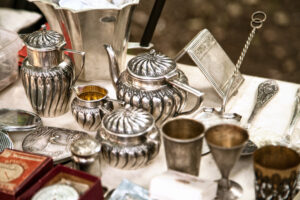
(Image via Getty)
The internet and television are replete with articles and shows about how to declutter your life. This includes everything from throwing out old dance recital costumes to tossing old canned goods to clearing out computer files filled with old, blurry photos. For those of us who do not lead clutter-free lives, distributing our estates, upon our passing, can be tedious, time-consuming, and frankly, unpleasant, for family, friends, and professionals charged with the task.
In talking to my clients about estate planning, they often raise the issue of “stuff.” In other words, what happens to all of their “stuff” when they die? First, a last will and testament is not going to inventory every single item that you own and direct the executor where to send it or how it should be preserved. Most last wills and testaments have a general close citing cars, boats, glass, appliances, clothing, books, jewelry, and bric-a-brac, which I choose to call chotchkes (think mini Eiffel Tower statue or “#1 Sister” trophy). If married, the tangible personal property is generally left to the spouse. If there is no spouse, then to the testator’s descendants. Often the distribution of tangible personal property is left to the executor to sort out, after the last will is admitted to probate. This means that the executor inventories your home and decides who gets which item, taking into consideration the beneficiary’s wishes and the items’ values. The rest of the items (that no one wants) is sometimes sold, but often thrown out or removed by junk-removing companies.
In many states, testators leave a special memorandum with their last will and testament. This is a document separate from the last will which notes particular tangible items and to whom the testator wishes the executor to distribute to upon the probate of the last will. The last will may reference the memorandum and incorporate it into the terms of the last will, depending on the state’s laws. Under the memorandum, a testator will often include specific directions as to jewelry or family memorabilia. A memorandum is used for several reasons. Often tangible personal property is hard to locate upon a testator’s passing. The gold bracelet mentioned in a last will may be hard to identify or even find. Distributions under a memorandum are often unenforceable as to the value of the item, if it should go missing. Moreover, if not specifically listed in the last will, it provides privacy for the testator so that the public and the family does not see what exactly is being distributed to each individual.
Often, tangible personal property, like jewelry, is transferred during a testator’s life, especially as one ages. This prevents fighting after death as to whom should get what piece of jewelry or which set of candlesticks, and it also gives the testator the joy of seeing the gift realized. Of course, many proceedings arise after death as to whether or not the transfer was an actual gift or if it was a conversion. Therefore, if one anticipates family litigation as to tangible personal property, be certain to document the gifts as to date, value, and other circumstances.
For items not listed specifically in a memorandum or in the last will, the executor will need to decide next steps. Often items are of little monetary value, but of great nostalgia. As an executor, I am thrilled when beneficiaries wish to receive undesignated tangible personal property because it relieves the pressures of emptying a residence, trying to sell unmarketable items, or looking for opportunities to donate. In this day and age, there are not many outlets for CDs, cassette tapes, and VHS tapes. Old televisions and stereo systems are not wanted. Libraries often request a monetary donation with books in order to sort through and organize them. Junk removal services charge significant fees to take items out of a residence. That’s right, an estate will pay a company to remove a decedent’s entire life. Simply, your stuff is not marketable.
Not everyone is a celebrity whose personal effects are in demand. Famed Hollywood actress Doris Day’s personal property will be put on auction in April. Included in the collection are her awards, a Valentino outfit, and gifts from Rock Hudson and Paul McCartney. Famous chef Anthony Bourdain’s items, including a knife he used, were recently put up for auction. This summer, Madonna lost an appeal to stop the auction of a 1995 letter written by TuPac Shakur to her, while he was in prison. In the letter, he breaks off their relationship. The public wants TuPac’s stuff. Yours, probably not.
It is hard to manage the clutter in our lives while we are alive, and it is even more difficult when we pass away. In considering one’s estate plan, besides the big-ticket items such as children, real estate, and brokerage accounts, be sure to pay attention to the small stuff. One’s legacy should include a somewhat organized and thoughtful distribution of personal items, so that one’s wishes can be carried with dignity and efficiency.
Cori A. Robinson is a solo practitioner having founded Cori A. Robinson PLLC, a New York and New Jersey law firm, in 2017. For more than a decade Cori has focused her law practice on trusts and estates and elder law including estate and Medicaid planning, probate and administration, estate litigation, and guardianships. She can be reached at cori@robinsonestatelaw.com.

